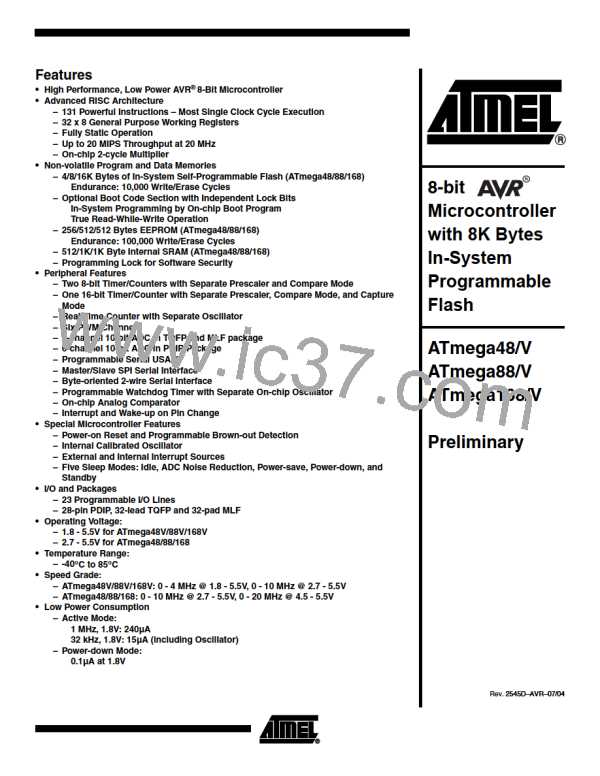ATmega48/88/168
part of the Z-pointer. The data in R1 and R0 are ignored. The PGERS bit will auto-clear
upon completion of a Page Erase, or if no SPM instruction is executed within four clock
cycles. The CPU is halted during the entire Page Write operation if the NRWW section is
addressed.
• Bit 0 – SELFPRGEN: Self Programming Enable
This bit enables the SPM instruction for the next four clock cycles. If written to one
together with either RWWSRE, BLBSET, PGWRT or PGERS, the following SPM
instruction will have a special meaning, see description above. If only SELFPRGEN is
written, the following SPM instruction will store the value in R1:R0 in the temporary page
buffer addressed by the Z-pointer. The LSB of the Z-pointer is ignored. The SELF-
PRGEN bit will auto-clear upon completion of an SPM instruction, or if no SPM
instruction is executed within four clock cycles. During Page Erase and Page Write, the
SELFPRGEN bit remains high until the operation is completed.
Writing any other combination than “10001”, “01001”, “00101”, “00011” or “00001” in the
lower five bits will have no effect.
Addressing the Flash
During Self-
Programming
The Z-pointer is used to address the SPM commands.
Bit
15
Z15
Z7
7
14
Z14
Z6
6
13
Z13
Z5
5
12
Z12
Z4
4
11
Z11
Z3
3
10
Z10
Z2
2
9
Z9
Z1
1
8
Z8
Z0
0
ZH (R31)
ZL (R30)
Since the Flash is organized in pages (see Table 122 on page 274), the Program
Counter can be treated as having two different sections. One section, consisting of the
least significant bits, is addressing the words within a page, while the most significant
bits are addressing the pages. This is1 shown in Figure 118. Note that the Page Erase
and Page Write operations are addressed independently. Therefore it is of major impor-
tance that the Boot Loader software addresses the same page in both the Page Erase
and Page Write operation. Once a programming operation is initiated, the address is
latched and the Z-pointer can be used for other operations.
The only SPM operation that does not use the Z-pointer is Setting the Boot Loader Lock
bits. The content of the Z-pointer is ignored and will have no effect on the operation. The
LPM instruction does also use the Z-pointer to store the address. Since this instruction
addresses the Flash byte-by-byte, also the LSB (bit Z0) of the Z-pointer is used.
261
2545D–AVR–07/04

 ATMEL [ ATMEL ]
ATMEL [ ATMEL ]